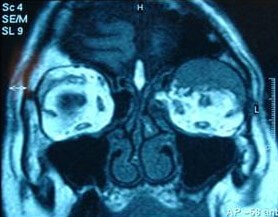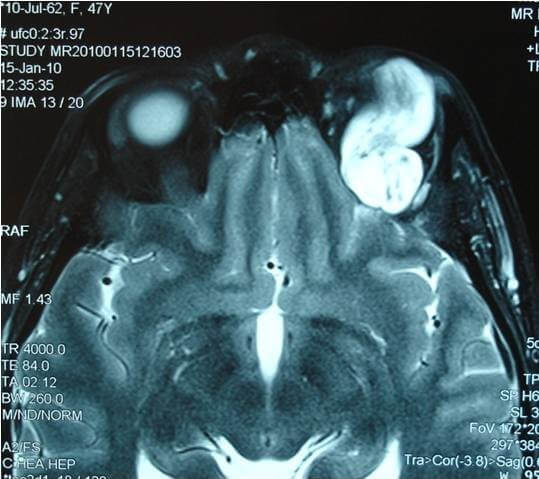
-
What is an orbital tumor
An orbital tumor refers to any tumor located in the bony socket located in the front of the skull. This socket is a complicated structure that contains the eye itself along with muscles, nerves, fat, vascular, glandular and connective tissue.
Orbital tumors can be benign or malignant, and they can be primary (meaning the tumor originates there), secondary from an adjacent source such as the eyelid, paranasal sinus and intracranial compartment , or metastatic from distant sites (meaning the tumor represents the spread of another cancer elsewhere in the body).
Some orbital tumors occur most commonly in children, other types are more often diagnosed in adults.

-
Pediatric orbital tumors
Capillary hemangiomas are the most common benign orbital tumors found in children. They tend to spontaneously involute and therefore usually do not need any treatment; however, especially when located on the upper eyelid, they may affect vision and require treatment with systemic beta-blockers.
Other benign orbital lesions include dermoid cysts, lymphangiomas, and histiocytic tumors
Treatment of dermoid cysts is excision. Small lymphangiomas that do not cause symptoms may be followed clinically. For larger lymphangiomas or those that are causing symptoms, options include surgical debulking, and intralesional sclerotherapy.
Rhabdomyosarcoma, is the most common primary malignant orbital tumor in children. If rhabdomyosarcoma is resectable, surgery is done, followed by chemotherapy and orbital radiation therapy.
Neuroblastomas, Ewing sarcoma, Wilms tumor, and leukemias are the most common metastatic orbital lesions afflicting children. Leukemic disease is usually managed by orbital radiation therapy, chemotherapy, or both.
-
Adult orbital tumors
Cavernous hemangiomas (cavernous venous malformations) are the most common benign orbital tumors in adults. Management of these lesions is dependent on the presence or absence of symptoms. For small, asymptomatic lesions, periodic observation is appropriate. For larger lesions causing diplopia, visual disturbances, or significant proptosis surgical excision is the treatment of choice.

Lymphoma is a cancer of the blood in which specific white blood cells (called lymphocytes) become cancerous. Orbital lymphoma accounts for 55% of malignant orbital tumors in adults. Lymphomas involving the orbit are typically B-cell and characteristically low grade. Lymphomas can be bilateral and simultaneous and can be part of a systemic process or exist in the orbit in isolation.
Radiation therapy effectively treats orbital lymphomas with few adverse effects, but treatment with monoclonal antibodies against a surface receptor (CD20) on the lymphocyte is also effective and should be considered in addition to or instead of radiation therapy, particularly if lymphoma is systemic.
Other adult orbital tumors include the following:
- Meningiomas - tumors that arise in the meninges, the protective covering that surrounds the brain and optic nerves
- Schwannomas/neurofibromas - from the Schwann cells in the sheaths that cover nerves
- Optic gliomas - from glial cells, the supporting cells in the brain
- Osteomas/ossifying fibromas - tumors that develop in bone
- Lymphangiomas /hemangiopericytomas - from the vascular system
- Sarcomas - from surrounding fatty tissue or muscle
- Paranasal sinus tumors and mucoceles - growths that extend from the sinuses into the orbit
- Cancers of the skin of the eyelid - these can include squamous cell carcinoma, basal cell carcinoma and even rare tumors such as sebaceous cell carcinoma and Merkel cell carcinoma
- Metastatic tumors- tumors that spread to the area from other parts of the body
- Lacrimal gland tumors - these can include pleomorphic adenoma, adenoid cystic carcinoma, malignant mixed tumor, adenocarcinoma, and mucoepidermoid carcinoma

-
Orbital tumors and symptoms
Since the orbit is a relatively small anatomical area with little wasted space, even a tiny tumor in this crowded space can cause significant symptoms and functional problems. The most common presenting symptom of an orbital tumor is proptosis. Other symptoms may include:
- Double vision
- Vision changes or loss
- Uncoordinated eye movement
- Numbness or tingling around the eye
- Pain around the eye
- Swollen or droopy eyelid
Because these symptoms may mean many things other than an orbital tumor, patients experiencing them should be examined by a specialist if a tumor is suspected.

-
Orbital tumors and diagnosis
Imaging studies are essential to diagnosis of tumors of the orbit. Both magnetic resonance imaging (MRI) and computed tomography (CT) scans can be used. For either study, an agent that provides contrast in the image is administered intravenously so Dr Mavrikakis can visualize the tumor against the normal tissue in the background.
In addition, a biopsy also may be conducted so the tumor tissue can be examined under a microscope to provide a definitive diagnosis.
-
Orbital tumors and treatment
The optimal treatment for orbital tumors is sometimes, but not always, surgical removal of the tumor. Due to the delicate nature of the eye and its surroundings, an orbital surgical specialist is recommended.
When the tumor includes sinus or intracranial pathways, a highly specialized multidisciplinary approach is recommended.
In cases where the tumor may be inaccessible or the risk may be too great to eye and vision, non-surgical treatment options are available including stereotactic radiation or chemotherapy.
Eyelid, Lacrimal & Orbital Diseases
Learn more about the disease you are interested in

